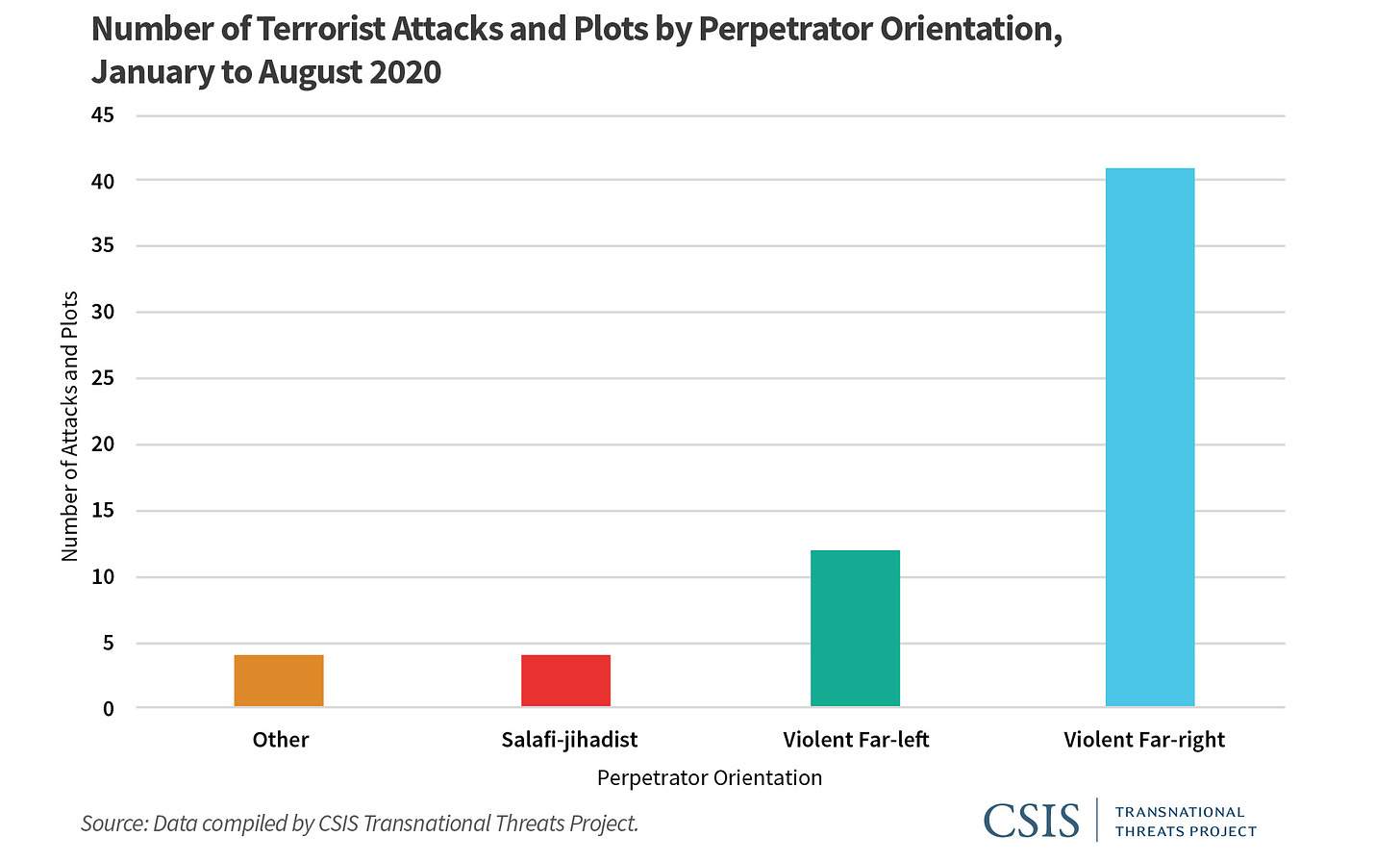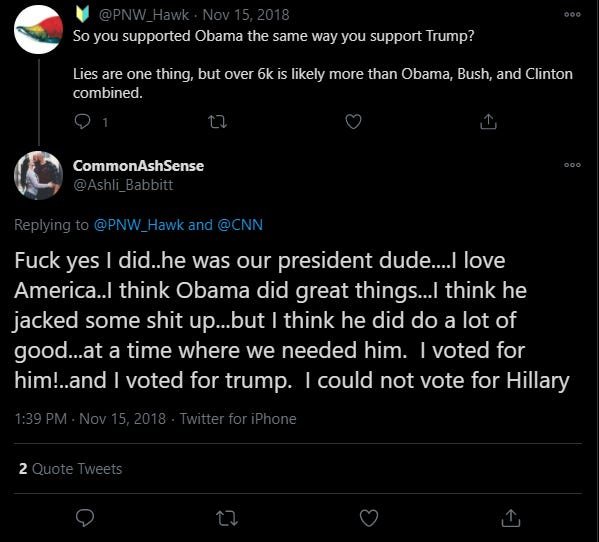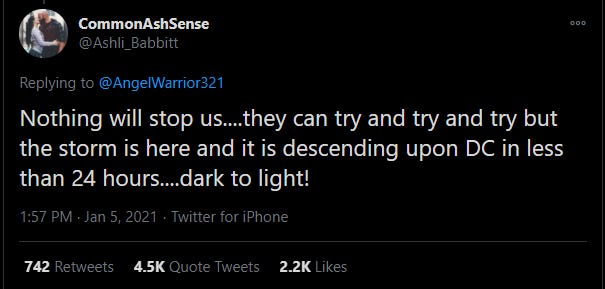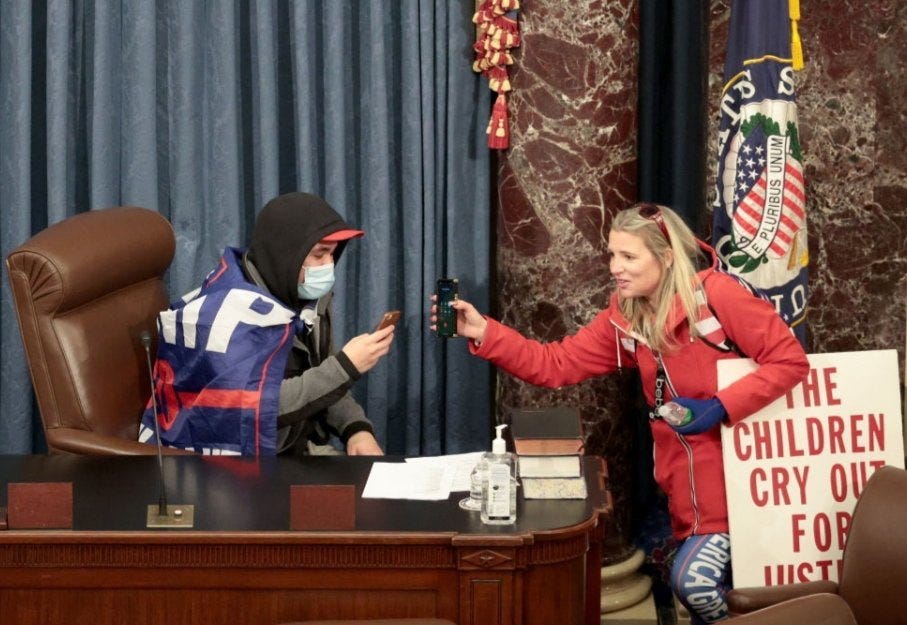What Data Show About Censorship of Conservatives and the Critical Details We're Missing
An evidence-based look at the social media purge following the Jan 6, 2021, attack on the Capitol.
Whether we agree with conservatives, if they’re being censored, that should concern us all.
Let’s look at what we know. Twitter was the most transparent openly sharing that removed 70,000 accounts linked to Qanon conspiracy theories and other violent extremist activity. The FBI and Homeland Security have regarded Qanon as a domestic terror threat since 2019. However, violence from the group came even before that, an astonishing reality for a four-years-old movement.
Total Twitter Users: 321,000,000
Accounts Removed: 70,000
Percent Removed: 0.02% of users
People who spread Qanon content are still on Twitter. Whatever the standard applied was, it probably wasn’t broad enough. Time will tell. Conservatives are also still present on the platform. Elected officials frequently use the platform for strategic messaging. That has sometimes included low-quality sources that also push Qanon's beliefs. Facebook booted those that shared content tied to extremist activity.
We do not know how many posts Facebook removed, but we can estimate. It’s reasonable to assume that the number of accounts removed from Facebook is much larger than those removed from Twitter. Facebook has the largest anti-vax community, for example, 31 million users. It dwarfs Twitter’s 2 million anti-vax accounts. This likely has to do with the benefit of Facebook groups, where people privately share information and organize.
Anti-vaccine groups increasingly overlap with Qanon conspiracy theorists. If we use the ratio of Facebook to Twitter for anti-vaccine users, it’s a 16:1 ratio. That means an equally proportional removal on Facebook would ban 1.1 million accounts. That number is likely too high. Facebook is known for ignoring its own policies for profit, and it makes massive profits off of anti-vaccine and extremist groups.
Still, let’s assume Facebook was as aggressive as Twitter, even though it has not been historically. Facebook has 2.7 billion users in total, so removing 1.1 million would be a similarly minuscule percentage of total users.
Total Facebook Users: 2,700,000,000
Accounts Removed: 1,100,000
Percent Removed: 0.4% of users
The number of removed accounts is well below the known estimates for users in extremist groups on the platform, so even within extremist groups, they have not universally removed people.
What Impact Has the Purge Had on Social Media?
The hashtags #FightForTrump and #HoldTheLine declined by 95% across platforms. Zignal, a firm that tracks online manipulation and misinformation, reported a 75% decline in misinformation and disinformation on social media platforms following the removal of President Donald Trump.
A study earlier in the year found that President Trump was the most significant driver of misinformation. His millions of followers then amplified anything he shared. This impact was noteworthy, but so is where we did not see an impact.
Let’s say there was an aggressive removal campaign on Facebook, way more than even the earlier estimate. If a systematic silencing of conservative voices occurred, that would significantly impact the top-performing posts on the platform. If that’s the case, we should be able to detect that at the population level instead of looking at a single person.
Facebook’s top-performing posts are well-known for being quite lopsided. Hyper-partisan right-leaning sources regularly ranked in 8 to 10 of the 10 top-performing posts before Jan 6, 2021. This creates an environment where fewer and fewer Americans hear all facts and multiple perspectives on a topic related to a situation. Conversely, if the opposite were true, that would also be problematic.
To gauge the impact of the purged accounts, I checked the top-performing posts on Jan 12 and 13 of 2021.



What’s noteworthy is these top articles aren’t sources of news. There’s almost no straight reporting. They’re political opinion or analysis sources—fine as a part of a media diet that includes reporting. Americans have poor media literacy, which no doubt contributes to the problem. A minority can even correctly identify fact versus opinion.
Spending years in that type of media environment has doubtlessly contributed to our growing division. Politico analyzed the performance of social media content in 2020, providing an example that demonstrates a dynamic common across platforms.
Lies make their way around the world before the truth can find its shoes:
Dan Bongino, a conservative commentator with millions of online followers, wrote on Facebook that Black Lives Matter protesters had called for the murder of police officers in Washington, D.C. Bongino is White and not involved with the movement in any way.
The claims — first made by a far-right publication that the Southern Poverty Law Center labeled as promoting conspiracy beliefs— were not reflective of the Black Lives Matter movement.
Bongino’s post was shared more than 30,000 times, and received 141,000 other engagements such as comments and likes, according to CrowdTangle.
In contrast, a post about Black Lives Matter, shared by actor DL Hughley attracted only 25% of the traction of Bongino's post. Hughley himself is Black.
The reality of conservative domination of the platform even after banning users en masse is unexpected. An anti-conservative bias on platforms is an assumed truth, but it’s shockingly thin on supporting evidence. Facebook commented on that reality this year.
“Right-wing populism is always more engaging,” a Facebook executive said in a recent interview. The right is better at producing content that provokes “an incredibly strong, primitive emotion” by touching on such topics as “nation, protection, the other, anger, fear.”
The six mailers on my desk that say, “Don’t let the radical left take our country,” and the blocked call I got reminding me “Biden will defund the police” suggest the executive may be right. What then is driving the perception of censorship, and is it conservativism that platforms are biased against, or something else?
Purges from the Past
The last major de-platforming happened to the Jihadist group ISIS. Americans lacked a shared culture with extremists outside the US, so it was easier to draw a line and say they had crossed it. Qanon is difficult to remove for the same reasons it’s so successful and dangerous. Someone can look at Qanon content and not know that’s what it is. It appears at first to simply be a conservative movement. It is anything but.
Claims that the group fights to save children help to draw a wide variety of people. That it’s harder to recognize and may even appear harmless means someone could feel wrongly purged or silenced. Evangelical Christianity and Catholicism, to some extent, have woven Qanon into their communities. Popular outlets and leaders in both religious groups have promoted Q-related ideas.
Fusing extremist ideology with majority religion, politics, and culture is an existential threat that requires moderating. Liberals and independents must be careful not to use the situation to silence conservatives who aren’t problematic wrongly. A healthy democracy requires tolerance of other political views, essentially not attempting to eliminate your political opponent. At the same time, conservatives must resist the temptation to cry persecution. That will only hurt conservatives the most.
Yes, Many Conservatives Have Been Banned from Platforms Recently, But It’s Not Because They Are Conservative—That Matters.
This is one of those all squares are rectangles, but not all rectangles are squares situations. Conservativism is the rectangle. The trait for removal is the square. Are more right-leaning outlets and users banned or censored than independents or liberals? If I had money to bet, I would bet yes, they are. The key is that this does not necessarily show platforms removed them for being conservative.
It’s unlikely that Mr. Bongino has a large base of liberal readers, meaning conservatives—a lot of them—remain on social media. If they had removed a significant number of conservatives, the top 10 performing posts seem unlikely to have 8 or 9 right-leaning articles. This suggests that while the people removed may have been conservative, that’s not what got them banned.
The situation is not exact, but another way to explain it is the example of ISIS getting de-platformed. Someone could have claimed that platforms removed religious people or even Muslims. That would have been a similarly wrong/right statement. Yes, the people removed were religious, but that isn’t why those users were removed.
No, Conspiracy Beliefs and Extremism Aren’t Exclusive to Conservatives, but Qanon Is. We Must Face That.
That brings us to an uncomfortable truth: The US is experiencing a boom in domestic extremism, largely on the right. It’s not clear why, but the shelter-in-place orders allowed these communities more access to people, especially people eager to believe the pandemic is overblown.
Liberals and independents are susceptible to conspiracies too, but Qanon skews heavily to the right. Conservatives must face it—I’m not sure anyone else can do it for them. Far-left extremism had to be countered in the 70s and early 2000s, and the threat of jihadist extremism also required concerted counterterrorism. The good news is that we have some idea of how to respond to these groups, but we must do something. We cannot continue to deny it.
Uncertainty brought on by the pandemic created a perfect storm for people to be pulled into these movements. Uncertainty can make us paranoid, regardless of how paranoid we are normally. At the same time, a crisis makes us more likely to rely on existing beliefs, struggle to take in new information, and trust the first message we hear. Later evidence can fail to persuade people in a crisis, which illustrates why pandemic communication failures in the US have been so damaging.
Far-right extremism has far outpaced any other form of extremism, and it is by far the most deadly. From 1994 to 2021, far-right extremists have killed 336 people in the US. At that same time, 1 death has been attributed to Antifa. Not since the Oklahoma City Bombing have we seen far-right extremism this active. Chief among the extremist groups threatening the US today is Qanon, a threat recognized by the federal government in 2019. Already this new movement is more deadly than the infamous and oft-discussed Antifa.
Qanon Polluted Social Media Rapidly
From early 2020 to late 2020, the percentage of Americans familiar with the movement doubled from 23% to 47%. Among Americans who had heard of Qanon, around 40% of Republicans responded that it is “somewhat good” or “very good” for the country. Among those who had heard Qanon beliefs, around 40% of Republicans said they were “very accurate” or “somewhat accurate.” Independents and Democrats were both under 18% on that question, and both were far more likely to recognize it as “very inaccurate” or “somewhat inaccurate.”
A whopping 39% of Americans believe in a deep state working to undermine President Trump, a cornerstone of Qanon. It’s unlikely all are aware of the connection to domestic terrorism. Demographic research shows two groups as the primary drivers of Qanon belief in the general population: “Republicans” and “FOX News viewers.”
A majority of both groups believe in the same deep state as Ashli Babbitt, the woman shot trying to break into the Speaker’s Lobby at the Capitol. Two groups that ranked as a close third: “White men” and “rural residents” at 49% each, believe in this nefarious deep state.
Good, this movement definitely is not.
Not all conservatives believe in Qanon. Not all believers understand the claims are false or how they tie to domestic extremism.
Not all conservatives believe in or approve of Qanon, but a big fraction does, affecting the group. It affects their conversation, priorities, and it changes them. See the Evangelical and Catholic groups taking on Q-tones from earlier.
Both groups once said, “Render unto Caesar the things that are Caesar’s,” now, we see USA-themed rosaries. This marks a worrisome shift where we see a desire to integrate church and state, which began in 1954. For over 175 years before that, we saw no mention of God in the Pledge of Allegiance or on money. Trying to merge the two is one likely reason for the continued turmoil in the Middle East, though not the lone reason.
Ideology doesn’t stay neatly sorted.
Closely associated groups bleed into one another like drops of ink in water. Need proof? What do the pro-life movement and climate science denialism have in common? Nothing, except now they are associated. Why are publicly funded schools, libraries, roads, government subsidies for farms, and law enforcement not socialism but affordable healthcare is? Parties simply make us believe illogical things.
In a party, ideas often tie together by association. A party encourages group-think, which may have been necessary before we had access to information about issues like today. Now, they are an arcane crutch that can make even college-educated Republicans deny the climate is changing. Qanon is far worse than partisan blind spots.

Qanon, a Domestic Terror Threat Known to the FBI and DHS, Has Reached the Highest Offices.
America just got her first two Qanon-affiliated Congress members. It’s unlikely to stay out of policy because the movement radically alters followers’ perception of reality. The important thing here is that it wasn’t always a part of conservativism, so we must distinguish them.
That the RNC funded those members’ campaigns is further worrisome. Has the party embraced Qanon informally? Maybe.
The President has refused to condemn and simply affirmed that he would save the world from “radical leftists.” In 2020, the political appointee leading Homeland Security, Chad Wolf, stated Qanon was not a threat. That conflicted with its established history of violence from the group and the intelligence community consensus.
For context, Wolf blocked the release of an intelligence bulletin in July 2020 that warned Russia intended to cast doubt on President-Elect Joe Biden’s mental health. Claims about Biden’s cognitive decline came from associates and Trump himself by Oct 2020. The Trump campaign had aligned with, and therefore aided, a foreign adversary’s assault on the American public’s grasp on reality.
Under Wolf, the Department of Homeland Security came under fire in another instance after someone edited a threat assessment such that it downplayed the role of far-right extremism. Critics were quick to point out that the skewed picture painted by the threat assessment didn’t just make us less safe, it matched the message of the Trump administration’s re-election campaign.
Two former national security officials who stepped down from the Trump administration have said the intention was to be vague so that the President could imply the threat was Antifa. Divisive, false claims about Antifa or Black Lives Matter is yet another alignment with our adversaries' disinformation campaigns.
Neumann: former Deputy Chief of Homeland Security | Olivia Troye, VP Pence’s Homeland Security Advisor | The Bulwark: an outlet by conservatives who refused to compromise on ethics to support Trump in 2016
Intentional or not, the edits and the President’s re-election campaign aligned, and they aligned at the expense of our safety. Demonstrably, Wolf’s claim that Qanon was not a threat was questionable at best. The threat posed by Qanon was well known then as it is now. All the denial did is cost us time. Just as it was costly to the US to delay the response to Covid, this too has been costly.
Using broadly appealing ideas, Qanon pulls people into its circle, followed by love-bombing — manipulative positive attention — and eventual indoctrination, which looks a lot like the early stages of ISIS recruitment. Indeed, an independent analysis found that far-right groups had co-opted ISIS recruiting strategies.

Inattention has allowed these malignant ideologies to grip our country much like a cult. Qanon slogans started appearing on political merchandise from the Texas GOP this past August.
A Pro-Trump group called Turning Point hired cyber troops typically used to influence the public. These armies create a mirage of anything the buyer wants online: popularity, outrage, arguments, anything. Turning Point may be in hot water after advertising buses to Washington DC on Jan 6, 2020, fully paid for and arranged. A $500,000 bitcoin donation made anonymously in December 2020 from outside the US went to multiple far-right groups, and a person who had access to those funds implicated three Congressmen. That is currently under investigation.
Digital armies from domestic and foreign groups have created a sea of disinformation, and Qanon material makes up a big part of that. When we swim in it, we lose our ability to tell what is true. Shelter-in-place created a situation where more people were on the internet for longer than ever before. That was the fertile ground in which Q spread at light speed — and with tragic consequences.
The Cost of Q
These new converts leave behind broken families, divorces, and people who feel people have been stolen from them. Once someone is unduly influenced, a term referencing unethical influence over others as is found in cults, they can become highly resistant to new information, and families feel helpless to reclaim them.
The grief-stricken seek support by the thousands in online forums where they tell their stories. It’s the same story repeatedly told, like the broken record from hell. One by one, the people they knew were taken and replaced with a template, the Q template.
Whoever they were before is gone:
“My father isn’t my father anymore. He is a political statement. He is bigotry. He is conspiracy theories and violence.”
“Today, my mother said I want my daughter to be molested…I don't know if anyone has ever uttered such a hateful thing. And to their own child no less. I unleashed every one of the most hateful things from the darkest depths of my soul… I don't regret it. And I never will.”
“My son is so confused about his dad’s brainwashing. He wants to trust his dad, but I think at the same time doesn’t.”
“I just got off a long conversation with my mother where she had a full-on breakdown since I stated I was going to get a vaccine when it came available. She was crying and began to spout out all of the fabricated lies she read off Facebook or some other website.”
“My darling big sister is gone.”
“I knew my mum was into a few covid conspiracies from links she’d sent me, but it wasn’t until I got home and talked to her about it that I saw how far down the rabbit hole she’d gotten. Truly unbelievable nonsense. Obama being shot for child sex trafficking? Yeah, K.”
Qanon, Snatching the Souls and Sense Around the World
The woman who died storming the Capitol on Jan 6, 2021, after she was shot trying to enter the speaker’s lobby, became an avid Qanon follower in the past two years. She had moderate views up through the end of 2018. That was when her views begin to shift.
Her views were radically altered from a nuanced view to repeating the Q slogans we’ve come to know.
Without Qanon, Ms. Babbitt would likely be alive. That should concern us all, but especially conservatives because they are the ones most likely to lose family members to this movement.
How undue influence and conspiracy groups operate is poorly understood by the general public. A majority of people have little to no experience in government, let alone higher offices, meaning they won’t spot the parts of the story that don’t reflect our government. Pair that with the tendency to see ourselves as the exception, not susceptible, and we have a problem. Most of us are.
Recruitment would probably fail if they opened with: “Greetings! We’re a fringe conspiracy group that believes a satanic baby-eating cabal is ruling the world—want to join?”
Groups pull people in with a hook that has universal appeal: #SavetheChildren. Who is going to object to saving children? Only a monster, that’s who! And you’re not a monster, are you? OK, then help us save the children. So it begins.
The group often purports to be fighting against human trafficking. In reality, it’s been harmful to groups that do real work to fight human trafficking. That doesn’t stop members from genuinely believing that their cause is somehow saving people.
Note the woman in the image above depicted in the Capitol building during the attack on the Capitol. She quit her job as a school therapist, saying she would fight human trafficking and pedophilia. Educated, employed in a highly social setting, this still happened to her.
It can happen to anyone.
That is why platforms are taking drastic measures. This infectious ideology is tearing society apart. We don’t know how many people are affected. Still, on Facebook alone, 30 million users consumed Qanon content, far larger than the 1.1 million I estimated, which I suspect is far too high.
That removal might only be the tip of the iceberg. Cutting off the flow of this infectious madness when it was highly likely to lead to violence in the immediate future was the right call, but we may need to revisit individual cases when things calm down.
Most worrisome is that the research shows signs that these groups may be subject to influence operations. Essentially, someone may have figured out how to manipulate a large subset of the American population by introducing ideas and disinformation (intentionally false information) and quite successfully at that.
Finding the responsible party is a worthwhile endeavor because it is against the law for the government to use psychological operations on American citizens, and foreign actors may be sanctioned. The list of potential benefactors is short, but that’s for another day.

Q will continue to pop up on social media, and whatever claims people make, we must respond firmly and expose it for what it is. Talk to people you know. If you see them posting something about saving children, reach out and make sure they know about this threat.
We must accept that this is not an attack on conservatives; it’s not a political plot to censor people. This is the real world, and we’re trying to save lives and families.


















